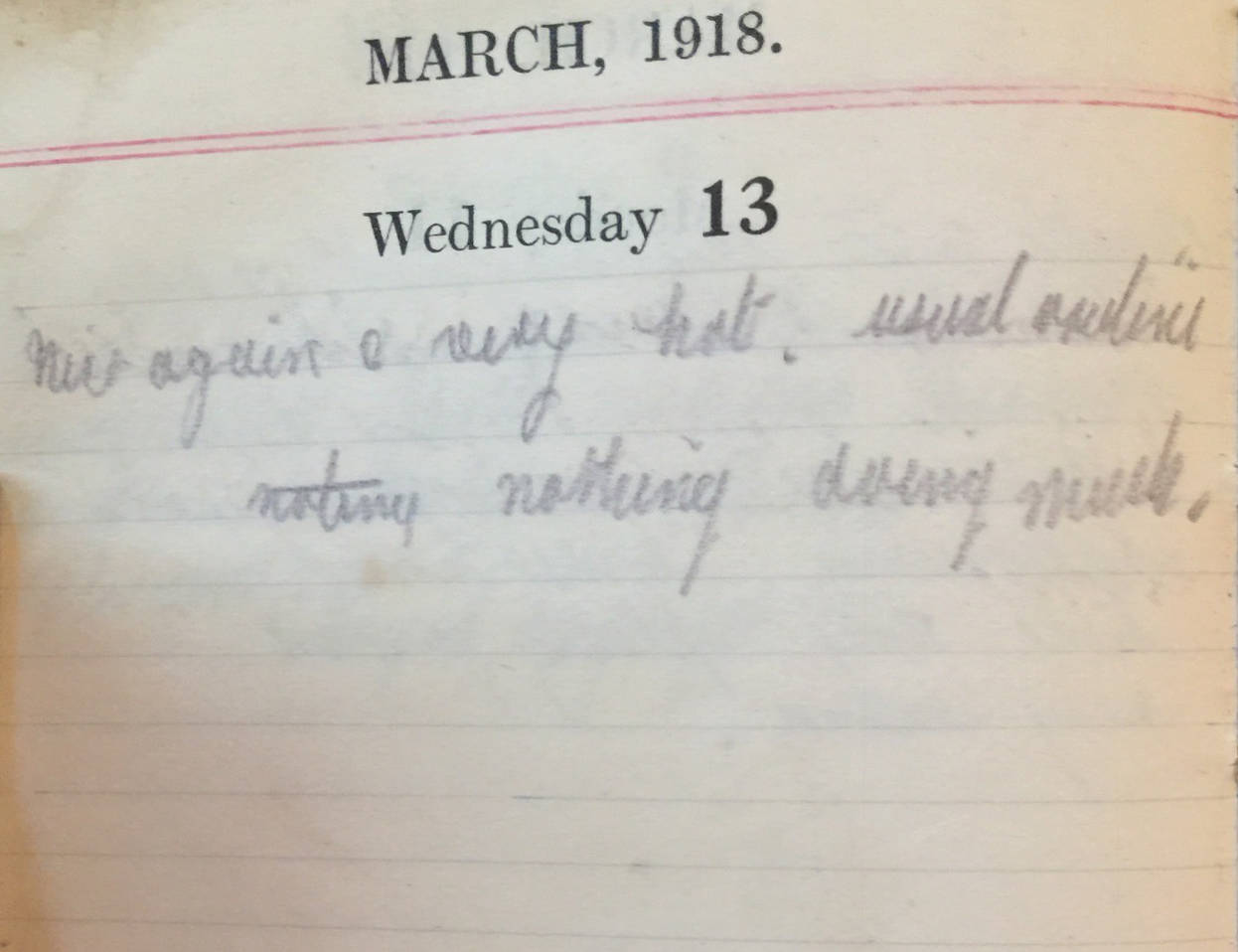Wednesday March 13th, 1918
Nice again and very hot. Usual routine. Nothing doing much.
Non-Commissioned Officers (NCO)
A Battalion comprised roughly a 1,000 men and was led by a Lieutenant-Colonel. Each Battalion contained an HQ and four Companies, each led by a Captain.

At Battalion HQ there would be a Captain acting as Adjutant (in charge of administration), another as Quartermaster (stores and transport), a Medical Officer from RAMC and a Chaplain (who may have more than one Battalion in his flock). There were also a variety of specialist NCO roles with Sergeants in transportation, signalling etc. One of these was the Armourer Sergeant (mentioned in the BWD today). He was usually a member of the Army Ordnance Corps (AOC), seconded to the Battalion to care for and repair the men’s rifles (and cycles!).²
This photograph shows members of the 4th Battalion at Denbigh Camp, 1913. Seated is Quartermaster Sergeant Len Worral, standing left to right is Sergeant J Gibson, Corporal George Elborough, and Armourer Sergeant J R Dudson. These were the only four men who were present at the 1913 Camp who had also seen service in the South African War 1899-1902.
A Company comprised four Platoons of 50 men each, led by a subaltern (either Lieutenant or Second Lieutenant) and supported by a Sergeant. Within the Platoon were four Sections of 12 soldiers led by a Corporal or Lance Corporal. Read more about the British Army’s structure here.
Training the Platoon for Battle
As the War raged on, the organization of Platoons and their battle tactics evolved. In February 1917, new instructions were issued in response to learnings from the Somme offensive. These started to formally expand the role of the infantryman beyond his trusty rifle and bayonet.
As Chris Baker describes, ‘The composition of the platoon was now to be a Platoon HQ (an officer (subaltern) and four men), with a Rifle section, Rifle Grenade Section, Lewis Gun Section and a Bombing Section (each Section being one 1 NCO and eight men). The riflemen were also to be trained to use the rifle grenade and also to be able to move into the Lewis Gun or Bombing Section as need arose.’ ¹
This ‘generalist’ trend continued to evolve and, ‘By 1918 all men were trained in the use of the hand and rifle grenade and specialist Bombing Sections disappeared. The Platoon was reorganised as three Sections (each armed with rifles, bayonets, grenades and rifle grenades and soldiers with flexible skills to use them all) and the Lewis Gun Section with two gun teams. Battalion HQ was also equipped with four Lewis guns.’¹
All this required the sort of additional training on weaponry and tactics that the 13th is undergoing now at Olasli and which Frank regards as the ‘usual routine’.
13th (Service) Battalion War Diary – 13th March 1918 – No 1 Sector, Olasli
Training is as per programme. All rifles have been inspected by the Armourer Sergeant. 18 OR having reported their arrival (Draft) are taken on the effective strength from 11-3-18. 2 OR have rejoined are are taken on from 11-3-18. 5 OR embarked at Salonica and disembarked at Malta on 11-3-18. 1 OR transferred to Labour Corps 21-2-18 and 1 OR 30-12-17. 15 OR invalided to England between 10-2-18 and 25-2-18. Captain CD Walker proceeded on leave to UK on 11-3-18. 2Lt J Byrne having returned from hospital is taken on the effective strength from 10-3-18. ?? Inter-Platoon Football.
References & Further Reading
¹ ‘What was a battalion of infantry?‘ Chris Baker in ‘The Long, Long Trail’
² ‘What did an AOC Armourer Sergeant do?‘ Invision Zone 1914-18
* Accession Number: KO2805/01 from King’s Own Royal Regiment


